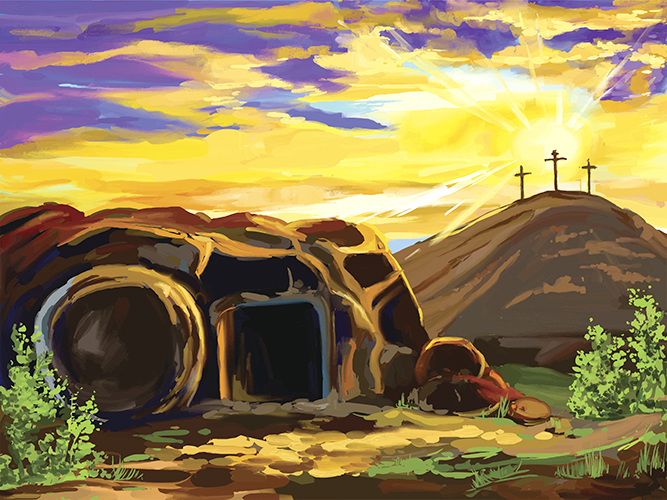Resurrection power: Jesus wields it as He wills

Easter, many good Christians insist, is a pagan name. Easter in 2021 is fast fading into history with all the thoughts of Easter eggs, cross buns, and whether it signals a time change in God’s weekly Sabbath. Bible students may have studied how the tearing of the veil of the temple from the top down, not from the bottom up, indicates that only God could have done it. One event of that day that seems less discussed is the departure of the bodies of dead saints from suddenly opened graves.
What was the rising up of those dead saints all about? Where were they headed? Are we not told that the righteous dead remain in their graves until summoned by the trumpet when Jesus returns?
This very interesting event is addressed in Matthew 27:52, 53. Nowhere else. In verse 53, Matthew records that the dearly departed saints “came out of the graves after his resurrection, and went into the holy city, and appeared unto many.”1
Some may consider Matthew’s report too good to be true because it is too strange to relate to. But there are good reasons why this event should not strike us with disturbing shock. Consider that this kind of event is not new to Scripture. In John 11:43, Jesus cries with a loud voice, “Lazarus, come forth.” And Lazarus, who had been dead four days, obediently answered the Master’s call.
And can we forget the drama of Ezekiel’s preaching to bones in the valley of the dry bones? (Ezek. 37). Can we forget the Lord’s question to Ezekiel, “Son of man, can these bones live?” (verse 3).
And, as Ezekiel prophesies and the Lord has promised, “the breath came into them, and they lived, and stood up upon their feet, an exceeding great army” (verse 10).
Vision and More
Of course, Ezekiel’s dry-bones experience was first a vision: the scattered bones were about Israel undone; their standing up and coming together as “an exceeding great army” was a prophecy about the restoration of Israel.
Lazarus’s resurrection was not mere symbol or mere metaphor. Nor was the raising of the only son of the widow of Nain on the way to his burial (see Luke 7:11-15). And, reiterating, Bible readers note the fact that the resurrected saints at the time of Jesus’ resurrection “appeared unto many.”
The fact of the dry bones in Ezekiel’s biblical account being symbolic does not mean that the vision is insignificant. If anything, it widens its relevance. Throughout the millennia, millions have had personal dry-bones experiences. I often describe my own years of spiritual wandering as years in the Valley of the Dry Bones. What my life and Lazarus’s resurrection have in common is their response to the Lord’s call to “come forth.”
The same is true of the underused story of Matthew 27:52, 53, where the resurrection of deceased saints gives witness to the life-giving power Jesus Christ declares that He wields as He wills (John 5:21).
What happens at Lazarus’s tomb and at the time of Christ’s triumphant crucifixion (Matt. 27:50-53) is but a foretaste of the glories of His second coming, when vastly more shall come forth, all those whose names are written “in the book of life of the Lamb slain from the foundation of the world” (Rev. 13:8).
The message of Matthew 27 is that after Christ’s resurrection, those saints whose graves were broken came out “and went into the holy city, and appeared unto many” (verse 53). Matthew is here at one with Paul’s teaching to the Thessalonians that “if we believe that Jesus died and rose again, even so God will bring with Him those who sleep in Jesus” (1 Thess. 4:14, NKJV).2 First, “the dead in Christ will rise first” (verse 16, NKJV); following which the living saints “shall be caught up together with them in the clouds to meet the Lord in the air” (verse 17, NKJV). Resurrection power, or call it what you will, and specifically at the time Jesus’ breath expires, at a moment when evil appears to triumph, is a climactic declaration of the utter supremacy of Him “who is the blessed and only Potentate, the King of kings and Lord of lords” (1 Tim. 6:15). “How appropriate that Christ should bring forth with Him from the grave some of the captives whom Satan had held in the prison house of death!”3
How appropriate, indeed.
1 Unless otherwise indicated, all Bible texts are taken from the King James Version.
2 Texts credited to NKJV are from the New King James Version. Copyright ã 1979, 1980, 1982 by Thomas Nelson, Inc. Used by permission. All rights reserved.
3 SDA Bible Commentary (Hagerstown, Md.:, Review and Herald Pub. Assn., 1956) vol. 5, p. 550.








